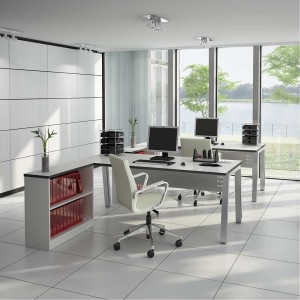 Whether you are running your own business or working for one, chances are you are spending several hours a day at your desk.
Whether you are running your own business or working for one, chances are you are spending several hours a day at your desk.This extended desk time not only eats into your personal life, but it can disrupt your work/life balance, it can also have dangerous ergonomic effects.
Ergonomics is the study of how we work, focusing toward working efficiently and effectively. When your workstation is not ergonomically sound, it can disrupt your work flow and lead to an injury.
Injuries related to poor ergonomics include carpal tunnel syndrome and back and neck strain. These injuries can cause a great deal of pain, which can disrupt your work flow.
You can adjust your workspace to be more ergonomically sound with a few simple steps.
Desk and Chair
Your desk chair should support your lower back and be adjustable so that you can control the height of the seat. Both your feet should be flat on the floor and your knees bent 90 degrees. The chair should have arm rests and be level with the top of your desk. If you are short and have trouble adjusting your chair so your feet remain flat on the floor, use a foot rest to raise the floor and support your feet and keep your knees in the correct position.
There should be enough space between your desk and chair for your legs to fit comfortably. The desk should also be wide enough to accommodate everything while still giving you ample room to work. A desk with a computer storage compartment will free up the desktop for writing and other work.
Another consideration is comfort level. This can be compromised by a cramped desk. If your current desk is not high enough to provide adequate leg clearance, you can find a replacement at an office workspace store like officedesk.com. They provide ergonomic office chairs and desks of various heights for any professional.
Finally, reduce the amount of clutter on your desk by keeping the things you aren’t using (such as files) in drawers. If you must have papers on your desk, put them in a desktop box or filing system.
Computer and Printer
The computer monitor should be an arm’s length away from your face. The top of the monitor should be at eye level so that you have to tilt your head down slightly to view the entire screen. Your keyboard should be placed so that your hands are slightly below or at the same level as your elbows. Your mouse should be within easy reach, on the same side as your dominant hand. There should be no obstructions on the desk that would impede mouse movement – you should not have to pick the mouse up to continue a motion.
To preserve space, consider keeping your printer on a separate surface near your desk, and within easy reach, such as a credenza behind your desk. If you must place the printer farther away, put it in an area that you can get to without having to stretch or climb over obstacles.
Supplies and Equipment
Supplies and equipment like pens or your desk phone should be within easy reach – you should not have to stretch or strain to access them. If you can’t reach something while seated, stand up to reach for it rather than stretching to reach it from a seated position.
Even small changes to your workspace can make a big difference in your workflow. Working more efficiently not only makes you more productive, it can also give you more free time with friends and family because you can work faster comfortably.